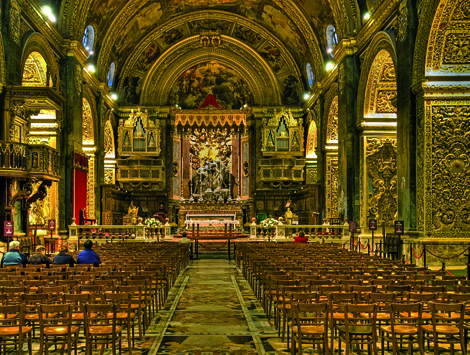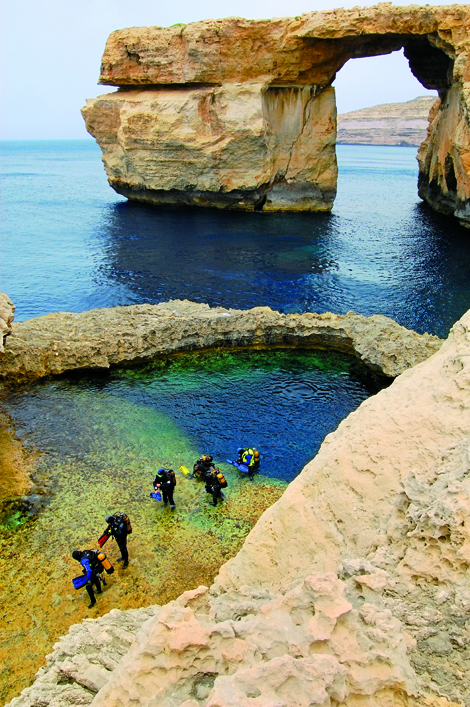Malta is the forgotten island of the Mediterranean. But with a wealth of unusual culture, cuisine and crusader history, it harbours more than its fair share of surprises, as Mike MacEacheran discovers
The first night of my stay in Malta is interrupted by explosions of fire. Rockets whistle past my ears and deafening canon shots crackle in the air, while thunderous booms reverberate across Valletta’s Grand Harbour. Considering Malta’s extensive history of mortar shots and musketeers, Ottoman sieges and Luftwaffe warfare, it comes as a surprise that the city is the annual host of the Malta International Fireworks Festival. From my vantage point on the ramparts of the Upper Barrakka Gardens, above an armada of yachts and cruise ships docked in the harbour, the city’s bastions could be under attack. City mayor Alexiei Dingli must surely see the irony.
In this respect, Malta is full of quirky surprises. Located in the southern Mediterranean, the island archipelago is a blend of Sicilian, Arabic, Turkish and British cultures and is different to any other in the region. To my surprise, I find that there are as many Italian pizzerias as Lebanese shawarma stands; as many red, blue and yellow Sicilian luzzu fishing boats as red postal letterboxes and English telephone boxes. People feast on rabbits at fiesta time, famous British actor and hell-raiser Oliver Reed has a bar dedicated to him (where he famously sank his last drink), and nonsensical poet Edward Lear once holidayed here – describing its craggy coastline as “pomskizillious and gromphiberous”. Somehow, the words I first heard as a child sum up these magical islands.

The day before I had been virtually kidnapped; stepping into the arrival hall at Malta International Airport, the most gregarious taxi driver I have ever come across decided to adopt me, my luggage and – with a “Welcome to Malta” screech – gave me a handshake strong enough to ruin my chances of ever being a bare-knuckle boxer. Then, bowling me over like a cannonball, he lunged for my bags and ushered me into his beat-up taxi faster than I could recall any pithy Italian phrase to simply ask his name.
He should have been employed by the Maltese Tourist Board. “Did you know that the islands were home to the oldest man-made settlements in the world? And that a ruined temple – at Hagar Qim to be precise – was 2,000 years older than the pyramids in Egypt?” For the record, I didn’t. I also didn’t know that Malta has the most widely photographed beach and lagoon in Europe. Or that it is regularly used as a backdrop for numerous big-budget film releases and has a bustling film industry – not that I would have known it on the quiet, cobbled backstreets of its capital Valletta. My taxi driver-cum-new best friend also told me about his wife, his son at college and tried to set me up with his daughter, which I politely, if embarrassingly, declined. Getting off the taxi at the Hotel Phoenicia I could see for myself how unique his hometown Valletta was.
A World Heritage Site since 1980, it is a labyrinth of ancient city gates, hanging gardens, piazzas, Gothic cathedrals, palaces and fortifications. In the words of Sir Walter Scott, it’s a city built by gentlemen for gentlemen, yet has only 6,500 permanent residents, making it the smallest in the EU – a pint-sized town that’s easy to criss-cross in half an hour. “You can’t get lost in Valletta,” a local told me. “All roads eventually lead back to the same place.” Without the need of a map, I ventured through its City Gate to explore.
Despite Valletta’s toy-town aesthetic, the city’s architects have squeezed a wealth of cultural draws into its miniature grid of streets and under its porticoes and porches. Baroque in design, the city has a number of grandstanding limestone façade buildings and crumbling forts – including the Grand Master’s Palace, the National Museum of Fine Arts and Fort St Elmo, home to the Malta War Museum. It’s also an appropriate setting for the Italian painter Caravaggio’s masterpiece, The Beheading of Saint John the Baptist, which was completed in 1608. Commissioned by the Knights Hospitaller of the Order of St John – a religious and military order charged with the defence of the Holy Land – this spine-tingling watercolour still hangs as the altarpiece in St John’s Co-Cathedral (www.stjohnscocathedral.com).
Valletta’s history is intertwined with the Order of St John. On the run from Ottoman Turks in the 16th century, the Knights arrived on the island with the backing of the Holy Roman Emperor Charles V, who proceeded to give the Hospitallers lordship of the islands in return for their religious servitude. Their tenure on the island was nearly short-lived, however; in 1565 a vastly superior Turkish armada invaded the island.
What happened next was one of the bloodiest and most fiercely contested battles in history, becoming one of the most celebrated events in 16th century Europe. As history shows, the Order of St John held off the invaders and was rewarded with financial aid from Rome with which to build a great city. Centuries later, as if one siege wasn’t enough, during World War II Malta was once again thrust onto Europe’s frontline when Hitler and Mussolini tried to starve the island into submission.
For today’s visitor, to picture this remote Mediterranean outpost at war takes some imagination. Life is slow and life ticks by at a humdrum pace. Nowhere is this more apparent than on the hushed squares of the medieval walled town of Mdina – only a short 40-minute drive from the capital – which I visit the following day. Known as the Silent City, Mdina could easily be separated by hundreds of years rather than a few kilometres from its neighbour. As the old capital of Malta, it has a minuscule population of 300 and is eerily quiet: on its maze of narrow streets lined with palazzos, cathedrals and a red sandstone Benedictine Monastery, so little has changed that it’s easy to forget it’s the 21st century and not the 16th century.
A similar experience is to be had at Marsaxlokk, a picture-perfect harbour village on the south coast, again only a short ride away from either city. Home to a large weekend market and the best seafood restaurants on the island – swordfish, tuna and the popular local fish lampuki are caught in abundance – its storybook feel comes straight out of a Popeye cartoon. Here, the traditional luzzu fishing boats are at their most majestic. Dozens moor in the azure waters, creating a vibrant backdrop from which to shop or simply watch the world go by, which in Maltese time can take all afternoon. Falling for the charms of a local waitress, I succumb to a plate of clams, mussels and fresh local fish that could easily have fed six men.
Back in Valletta, around the corner from the Manoel Theatre (www.teatrumanoel.com.mt), the restaurant Rubino (www.rubinomalta.com) is another welcome Maltese oddity. While the city disappears behind closed doors for the night, Mike Diacono opens his atmospheric cellar until late for diplomats, businessmen and tourists wanting a taste of recipes that most other island chefs have forgotten.
Like everything in Malta, the restaurant has its own fascinating history and has been serving classic dishes such as fenkata (rabbit stew with pasta), snails and sfinec ta l-incova (a deep-fried savoury doughnut with anchovies) since 1906. But that’s not all: it’s housed in an old confectionery store; then there is the fact that the waiters love to ply diners with free shots of the Italian liquor limoncello. “The best thing about Malta,” my waiter tells me, pouring another drink, “is us Maltese have learned the hard way how to make the best of life. Grilled rabbit is Malta’s most famous speciality but we also have the best mezze, the best wine, the best delicious snails and the best limoncello. This is all you need for good health!”
The following morning, with a heavy head and a heavier lemon-lined stomach, I retrace my steps to the Upper Barrakka Gardens for a final peaceful view of Valletta’s sun-bleached Grand Harbour. But then, at midday, the sky erupts with a thunderous boom once more. Two pounds of charred gunpowder have been fired from a saluting battery canon below me. As traditions go – this one dates back to Malta’s former British rule – it’s as surprising as every other aspect of this complex island. I should have known there would have been one final twist in store.

Gozo
Malta in Miniature
A 15-minute seaplane ride from Valletta Waterfront, the pocket-sized island of Gozo nudges against the top of Malta. From the bubble windows of the Harbourair plane (www.harbourairmalta.com), it appears as no more than a smudge on the map, but Gozo is in fact Malta in miniature: it’s home to abundant beaches, verdant farmlands and quiet coves and seascapes. It’s also got its own unique history too – Gozo is long rumoured to be the home of the nymph Calypso from Homer’s epic poem, Odyssey.
Here the pace of life is even slower than on its southerly neighbour – while ecotourism is on the rise, the few tourists that do visit rent a secluded cottage in one of a dozen tranquil villages and leave their mobile phone and watch in their suitcase; it seems as if time really does stand still here.
How to get there
From Hong Kong or Bangkok, Emirates offers the cheapest connection to Malta International Airport in Valletta via Dubai, while Lufthansa flies direct to Valletta with a short turnaround in Frankfurt. For a greater flight selection, Cathay Pacific flies to London where a number of budget carriers offer onward connections to Malta.








